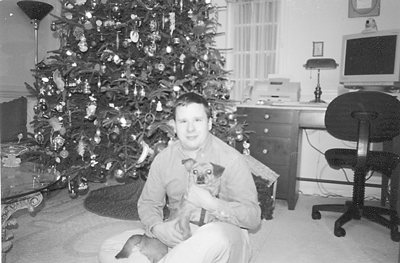A few days before Christmas in 2003, Brian Jordan, a gay man—who like many others in New York—was struggling with a crystal meth addiction, was found dead in the West Village apartment he was house-sitting while its owner was out of town.
Jordan’s naked and partly decomposed body was discovered on December 27.
In February 2004, the city’s medical examiner ruled that Jordan’s death was a homicide caused by “asphyxia, type undetermined.” The case remains unsolved and the police department declined to comment on the investigation.
That same Christmas season, Miguel, a gay man who is now 56 and asked that he be identified with a pseudonym, reunited with his sister and her family after years apart. He fought alcoholism and a crack cocaine addiction for years, but had sobered up.
“I can do that now,” Miguel said, referring to the time he spent with his family during the holidays. “I used to not be around for that.”
Miguel and Jordan never met, but the two men’s stories are characterized by a seldom discussed aspect of addiction that health experts say is a common characteristic among some alcoholics and drug users—mental illness.
Jordan suffered from a bipolar disorder, according to seven friends who knew him in New York and Chicago, all of whom requested anonymity and some of whom are themselves recovering from crystal addiction. People with a bipolar disorder swing between a manic phase of seemingly boundless energy and periods of depression that, left untreated, can lead to suicide.
Miguel was told in 1988 that he had bipolar disorder, but more recently was diagnosed with major depression.
It is not unusual for sufferers of serious mental illnesses, including schizophrenia and bipolar disorder, to use drugs and alcohol as a source of relief.
“People who feel bad are looking for a way to make themselves feel better,” said Christian Huygen, a psychologist and the director of the Rainbow Heights Club, a service center in downtown Brooklyn for lesbian, gay, bisexual and transgendered people who are living with serious mental illnesses.
Dr. Scot G. McAfee, who heads a psychiatric unit St. Vincent’s Hospital and Medical Center, said that roughly 50 to 75 percent of schizophrenics stop taking their prescribed medication at some point in their treatment and an estimated 50 to 65 percent of people who seek treatment for a bipolar disorder have a substance abuse problem.
Part of the challenge faced by health care providers is that the medications for these disorders can have unpleasant side effects. Alcohol and drugs can offer some relief without those side effects, and for some people the disorders induce occasional euphoria that they embrace.
“The medications can be very rigorous with many side effects,” said David Ferguson, director of the Manhattan West Greenberg Outpatient Clinic. “Many bipolar people don’t like taking them because they enjoy the manic phase. The medications for schizophrenics are better than they used to be, but they are still very difficult to take.”
Jordan often complained to friends that he gained weight from taking his medication and he felt that made him unattractive to other men.
“He was upset that he gained so much weight,” said a friend who knew Jordan from Crystal Meth Anonymous meetings, a 12-step recovery group. “I think what he hated the most was being fat because he had been a chubby kid.” The friend explained that Jordan felt that when he started gaining weight, his “erotic possibilities were limited.”
Other men from Crystal Meth Anonymous who knew Jordan said that their friend was embarrassed by his mental illness and by the need to take pills for it.
“He would discuss being ashamed of it,” said a second friend from the recovery program, echoing the view that Jordan feared that he was becoming unattractive. “He would discuss being forced to take things that made him unavailable to the gay community.”
Miguel said that his own medications cause impotence and limit his sex life.
“Sometimes you have to make a choice,” he said. “It’s either that or the depression.”
After six years of sobriety and getting support from social service agencies, Miguel said he has come to terms with his situation, including the inhibitions on his sexual performance.
“I think I accept it now,” he said. “It’s something that is probably going to be with me for the rest of my life.”
The shame associated with mental illness can prevent someone from seeking care or continuing with it, a stigma that is prevalent across society, not just among gay people.
“In the same way that there is a stigma in the general population, that is in the community as well,” said Eleanor C. Neely, director of mental health and social services at Lesbian, Gay, Bisexual and Transgender Community Center in Manhattan. “I don’t know that we are any better or any worse.”
There is little data on the prevalence of mental illness in the queer community. According to McAfee, schizophrenia occurs in about one percent of the overall population and about three to five percent experience some form of bipolar disorder. Ten to 20 percent of the U.S. population may contend with a major bout of depression in their lifetime.
The population of people who seek out social services at the Center roughly mirrors those numbers.
“Out of 1,200 folks we see a year, about 40 percent are coming in with mental health issues,” Neely said.
Of that 40 percent, Neely estimated that three to five percent were schizophrenic, five percent were bipolar and five percent suffered from severe depression.
Michael Altshuler, director of the Bronx Rehabilitation and Education in the Art of Living Center, a day treatment program where Miguel is a client, said that drug abuse among mentally ill clients is a continuing issue.
“What we see here is that virtually every client is on medication and, within the total group of clients who are taking meds, some will always have compliance issues,” he said. “What we find is that there are always, amidst a general population of clients, some clients who are mentally ill who are abusing drugs.”
While the stereotype of a mentally ill person is often of a delusional homeless person, encountered on the streets or in the subways, Miguel and Jordan may be closer to the typical story.
Miguel was born and raised in New York City. From 1977 until 1991, he worked at a local phone company. By then, alcohol had already become a problem.
“I was an alcoholic maybe since the age of 18,” he said. “I was a very shy kid. I guess maybe that’s why I took to drinking. When I went to gay bars, I would drink.”
Miguel sought help in two rehabilitation programs, but returned to using both times. At 41, he started smoking crack and for much of the 1990s he lived with friends, including a crack dealer, or was homeless.
He said his sister recently told him, “You disappeared. We didn’t know if you were alive or dead.”
Today, Miguel spends his time at the day treatment center that Altshuler runs in the Bronx, a unit of the Jewish Board of Family and Children’s Services. He lives independently on government disability payments.
“I depend on this place,” Miguel said, of the day treatment center. “I’m kind of spreading my wings here.”
Jordan’s life is much more difficult to piece together. He was in and out of Crystal Meth Anonymous so often that there were limits on how much his friends knew about him. No one could say precisely how old he was at the time of his death, though they assumed he was in his late 20s or early 30s. He arrived in New York City from Chicago in late 2001 or early 2002 and was already using crystal.
“He started hanging out a lot at the bathhouse here,” said a friend who lives in Chicago. “At one of the bathhouses, he met one of the dealers. It kind of started from there.”
Jordan worked as a computer programmer and apparently enjoyed some financial success. At one point, friends said, he owned a Jeep and had a small dog named Spike. For his favorite holiday, Jordan would lavishly decorate his Christmas tree.
“When he was here, he managed to maintain his job,” said the Chicago friend. “It wasn’t until he moved to New York that he really started having problems.”
Those problems appear to have mounted quickly. Jordan rented an apartment on the Upper West Side. He later claimed that he was about to be evicted, but a search of city housing court records showed no evidence of an eviction proceeding.
“He didn’t have any money to store it, so he just put everything he owned out on the street,” said a third friend from the Crystal Meth Anonymous meetings Jordan attended. “That was a huge blow to him. I think he was crushed about it.”
Jordan gave Spike to another friend. From that point forward—it is unclear if that happened in 2002 or 2003—Jordan was effectively homeless.
Friends said he often appeared at Crystal Meth Anonymous meetings and announced he had no place to stay. He would sleep on friend’s couches, at a transient hotel in the West Village and, one friend said, in city parks. On those occasions when he was able to get a stable living arrangement and to work, Jordan would inevitably spend his pay on crystal and hustlers, friends said. He was never able to stay off crystal for more than a few weeks.
In 2003, Jordan was hospitalized twice, once following a suicide attempt. Friends said that after that he seemed to have stabilized. He found work and was looking for an apartment, though it appears that at his death, he was back to using crystal.
Some friends believed that there had been a memorial service in New York City for Jordan. Others thought there was no service.
gaycitynews.com


































